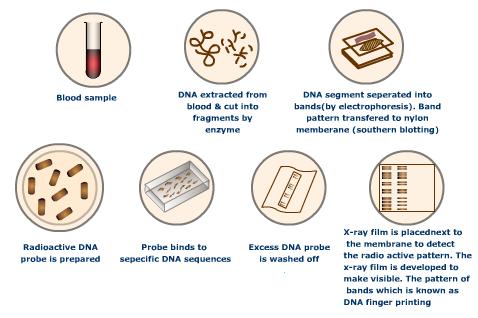4. Techniques of Analysis of Dna:
-DNA Fingerprinting:
The sections of DNA used in DNA fingerprinting, although highly variable, are passed down from parents to their children. Although not all of the sections will necessarily be passed on, no child has pairs that their parents do not have. This means that by comparing large groups of these sections, paternity, maternity, or even both, may be determined. DNA fingerprinting has a high success rate and a very low false-positive rate, making it an extremely popular form of paternity and maternity verification.
-The Polymerase chain reaction (PCR):
-DNA Fingerprinting:
DNA fingerprinting is a way of identifying a specific individual, rather than simply identifying a species or some particular trait. It is also known as genetic fingerprinting or DNA profiling or DNA typing or DNA testing. DNA fingerprinting is currently used both for identifying paternity or maternity and for identifying criminals or victims. There is discussion of using DNAfingerprinting as a sort of personal identifier as well, although the viability of this is debatable.
The vast majority of a human's DNA will match exactly that of any other human, making distinguishing between two people rather difficult. DNA fingerprinting uses a specific type of DNA sequence, known as a microsatellite, to make identification much easier. Microsatellites are short pieces of DNA which repeat many times in a given person's DNA. In a given area, microsatellites tend to be highly variable, making them ideal for DNA fingerprinting. By comparing a number of microsatellites in a given area, one can identify a person relatively easily.
-The Polymerase chain reaction (PCR):
The polymerase chain reaction (PCR) is a scientific technique in molecular biology to amplify a single or few copies of a piece of DNA across several orders of magnitude, generating thousands to millions of copies of a particular DNA sequence. The method relies on thermal cycling, consisting of cycles of repeated heating and cooling of the reaction for DNA melting and enzymatic replication of the DNA Primers (short DNA fragments) containing sequences complementary to the target region along with a DNA polymerase (after which the method is named) are key components to enable selective and repeated amplification. As PCR progresses, the DNA generated is itself used as a template for replication, setting in motion a chain reaction in which the DNA template is exponentially amplified. PCR can be extensively modified to perform a wide array of genetic manipulations.
Almost all PCR applications employ a heat-stable DNA polymerase, such as Taq polymerase, an enzyme originally isolated from the bacterium Thermus aquaticus. This DNA polymerase enzymatically assembles a new DNA strand from DNA building blocks, the nucleotides, by using single-stranded DNA as a template andDNA oligonucleotides (also called DNA primers), which are required for initiation of DNA synthesis. The vast majority of PCR methods use thermal cycling, alternately heating and cooling the PCR sample to a defined series of temperature steps. These thermal cycling steps are necessary first to physically separate the two strands in a DNA double helix at a high temperature in a process called DNA melting. At a lower temperature, each strand is then used as the template in DNA synthesis by the DNA polymerase to selectively amplify the target DNA. The selectivity of PCR results from the use of primers that are complementary to the DNA region targeted for amplification under specific thermal cycling conditions.
-Forensic Testing:
Forensic testing is the application of variou types of sciences in order to answer questions for the legal sytem. Testing takes various shapes and forms; one of the most common Modern approaches focuses on DNS testing.
There are several types of tests used by forensic scientists to identify both organic and inorganic substances involved in a crime. Fields involved include serology (blood testing), toxicology (the study of poisons) and DNA testing. Types of equipment used in forensic testing include spectrophotometers (to examine objects at wavelegths of light not visible to the naked eye), gas chromatographs (to separate components in a compound to analyse it more carefully) or fingerprinting analysis equipment (to compare a suspect's fingerprints with those found ata a crime scene).
-Paternity test:
A paternity test is conducted to prove paternity, that is, wheter a man is the biological father of another individual. This may be relevant in view of rights and duties of the father. Similarly, a maternity test can be carried out.
-Restriction Enzymes:
Restriction enzymes are DNA-cutting enzymes found in bacteria (and harvested from them for use). Because they cut within the molecule, they are often called restriction endonucleases.
In order to be able to sequence DNA, it is first necessary to cut it into smaller fragments. Many DNA-digesting enzymes (like those in your pancreatic fluid) can do this, but most of them are no use for sequence work because they cut each molecule randomly. This produces a heterogeneous collection of fragments of varying sizes. What is needed is a way to cleave the DNA molecule at a few precisely-located sites so that a small set of homogeneous fragments are produced. The tools for this are the restriction endonucleases. The rarer the site it recognizes, the smaller the number of pieces produced by a given restriction endonuclease.


.gif)

.jpg)








No hay comentarios:
Publicar un comentario